University: Information and Decision Making in Business Report
VerifiedAdded on 2022/10/08
|7
|1382
|29
Report
AI Summary
This report delves into the crucial aspects of information and decision-making within a business context. It commences by exploring the impact of new technologies on knowledge and information management, emphasizing tools like Enterprise 2.0 and Semantic Web. The report then examines statistical analysis and quantitative methods, including linear programming and game theory, commonly employed to enhance decision-making processes. Key features of management information systems (MIS) and decision support systems (DSS) are outlined, highlighting their roles in organizational control and decision efficiency. Furthermore, the report addresses risk management, defining its processes and strategic measures. Task 2 focuses on the government's perspective, analyzing relevant information, knowledge management strategies, and data dissemination methods within government organizations, referencing the Australian Local Government Association's knowledge management toolkit. The report concludes with an overview of how knowledge management influences government decisions and the various channels used for information dissemination.
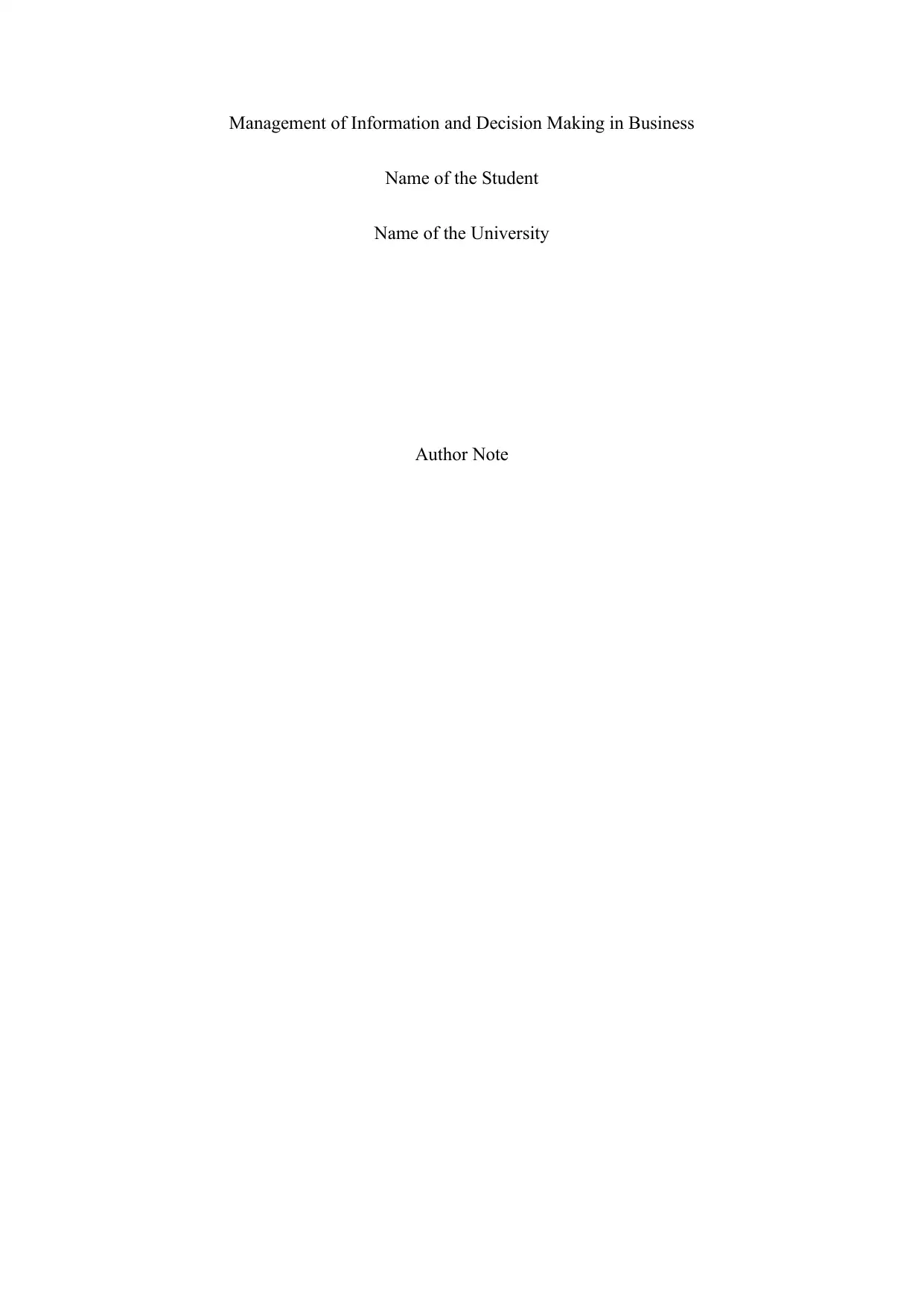
Management of Information and Decision Making in Business
Name of the Student
Name of the University
Author Note
Name of the Student
Name of the University
Author Note
Paraphrase This Document
Need a fresh take? Get an instant paraphrase of this document with our AI Paraphraser
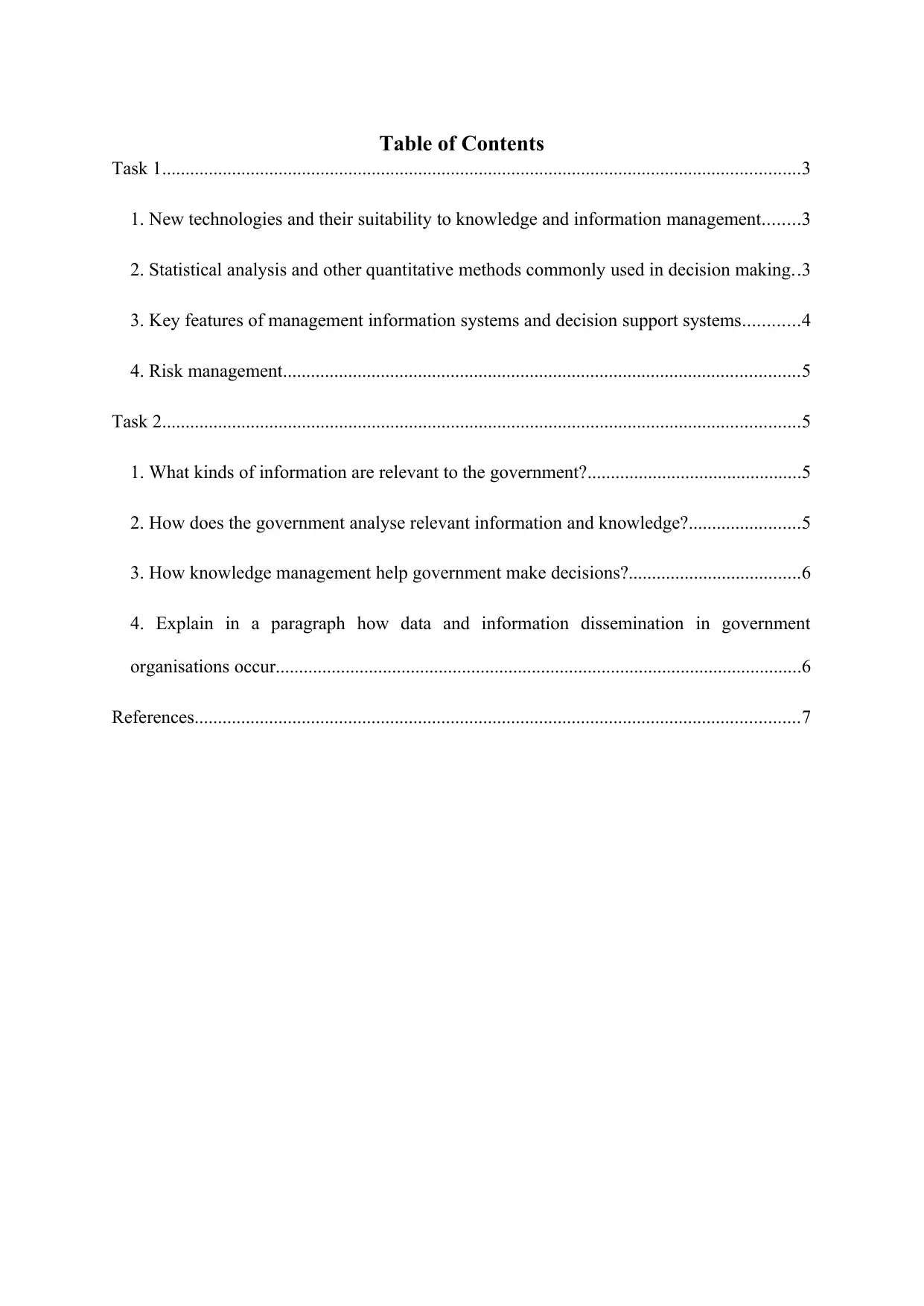
Table of Contents
Task 1.........................................................................................................................................3
1. New technologies and their suitability to knowledge and information management........3
2. Statistical analysis and other quantitative methods commonly used in decision making..3
3. Key features of management information systems and decision support systems............4
4. Risk management...............................................................................................................5
Task 2.........................................................................................................................................5
1. What kinds of information are relevant to the government?..............................................5
2. How does the government analyse relevant information and knowledge?........................5
3. How knowledge management help government make decisions?.....................................6
4. Explain in a paragraph how data and information dissemination in government
organisations occur.................................................................................................................6
References..................................................................................................................................7
Task 1.........................................................................................................................................3
1. New technologies and their suitability to knowledge and information management........3
2. Statistical analysis and other quantitative methods commonly used in decision making..3
3. Key features of management information systems and decision support systems............4
4. Risk management...............................................................................................................5
Task 2.........................................................................................................................................5
1. What kinds of information are relevant to the government?..............................................5
2. How does the government analyse relevant information and knowledge?........................5
3. How knowledge management help government make decisions?.....................................6
4. Explain in a paragraph how data and information dissemination in government
organisations occur.................................................................................................................6
References..................................................................................................................................7
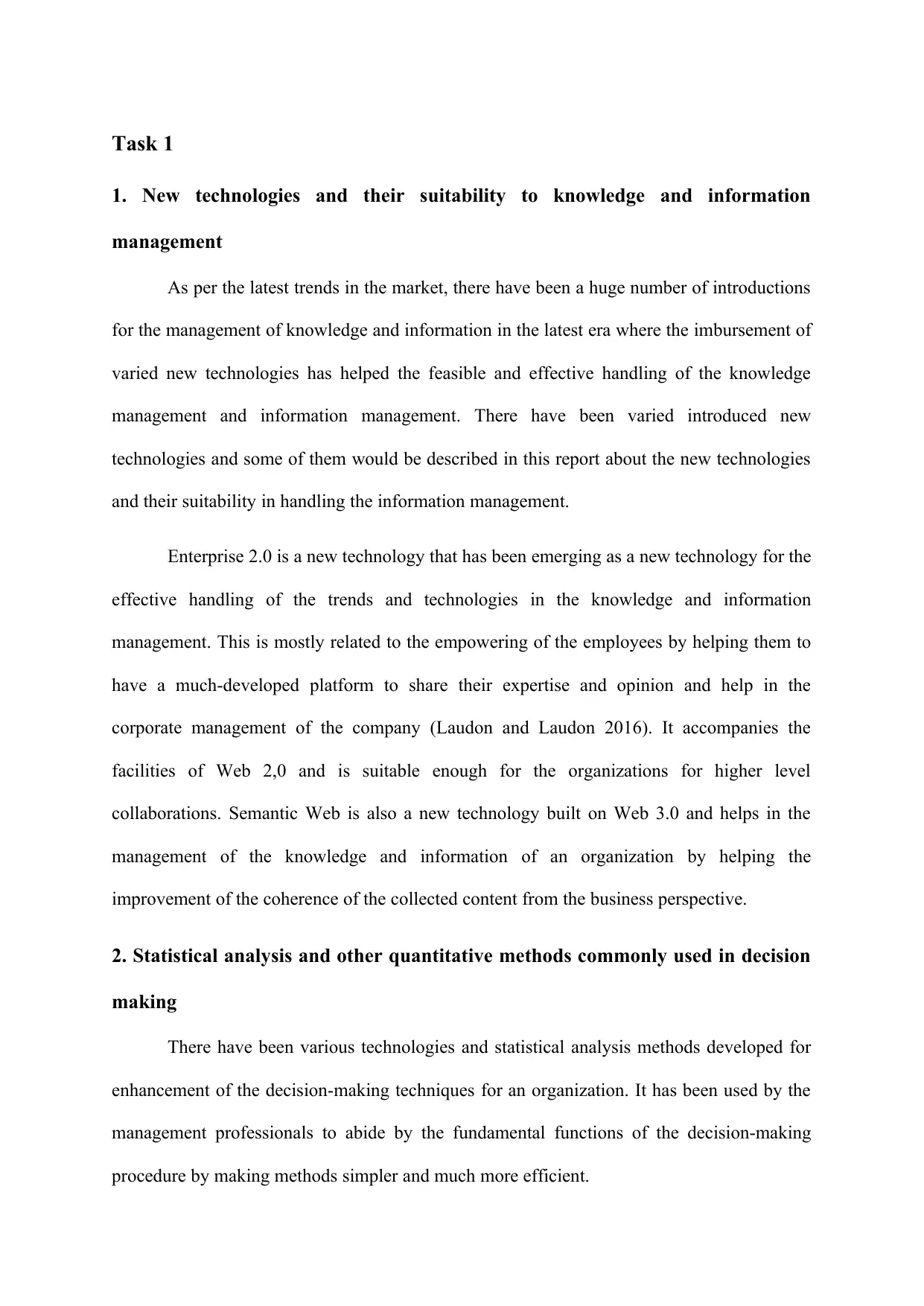
Task 1
1. New technologies and their suitability to knowledge and information
management
As per the latest trends in the market, there have been a huge number of introductions
for the management of knowledge and information in the latest era where the imbursement of
varied new technologies has helped the feasible and effective handling of the knowledge
management and information management. There have been varied introduced new
technologies and some of them would be described in this report about the new technologies
and their suitability in handling the information management.
Enterprise 2.0 is a new technology that has been emerging as a new technology for the
effective handling of the trends and technologies in the knowledge and information
management. This is mostly related to the empowering of the employees by helping them to
have a much-developed platform to share their expertise and opinion and help in the
corporate management of the company (Laudon and Laudon 2016). It accompanies the
facilities of Web 2,0 and is suitable enough for the organizations for higher level
collaborations. Semantic Web is also a new technology built on Web 3.0 and helps in the
management of the knowledge and information of an organization by helping the
improvement of the coherence of the collected content from the business perspective.
2. Statistical analysis and other quantitative methods commonly used in decision
making
There have been various technologies and statistical analysis methods developed for
enhancement of the decision-making techniques for an organization. It has been used by the
management professionals to abide by the fundamental functions of the decision-making
procedure by making methods simpler and much more efficient.
1. New technologies and their suitability to knowledge and information
management
As per the latest trends in the market, there have been a huge number of introductions
for the management of knowledge and information in the latest era where the imbursement of
varied new technologies has helped the feasible and effective handling of the knowledge
management and information management. There have been varied introduced new
technologies and some of them would be described in this report about the new technologies
and their suitability in handling the information management.
Enterprise 2.0 is a new technology that has been emerging as a new technology for the
effective handling of the trends and technologies in the knowledge and information
management. This is mostly related to the empowering of the employees by helping them to
have a much-developed platform to share their expertise and opinion and help in the
corporate management of the company (Laudon and Laudon 2016). It accompanies the
facilities of Web 2,0 and is suitable enough for the organizations for higher level
collaborations. Semantic Web is also a new technology built on Web 3.0 and helps in the
management of the knowledge and information of an organization by helping the
improvement of the coherence of the collected content from the business perspective.
2. Statistical analysis and other quantitative methods commonly used in decision
making
There have been various technologies and statistical analysis methods developed for
enhancement of the decision-making techniques for an organization. It has been used by the
management professionals to abide by the fundamental functions of the decision-making
procedure by making methods simpler and much more efficient.
⊘ This is a preview!⊘
Do you want full access?
Subscribe today to unlock all pages.

Trusted by 1+ million students worldwide
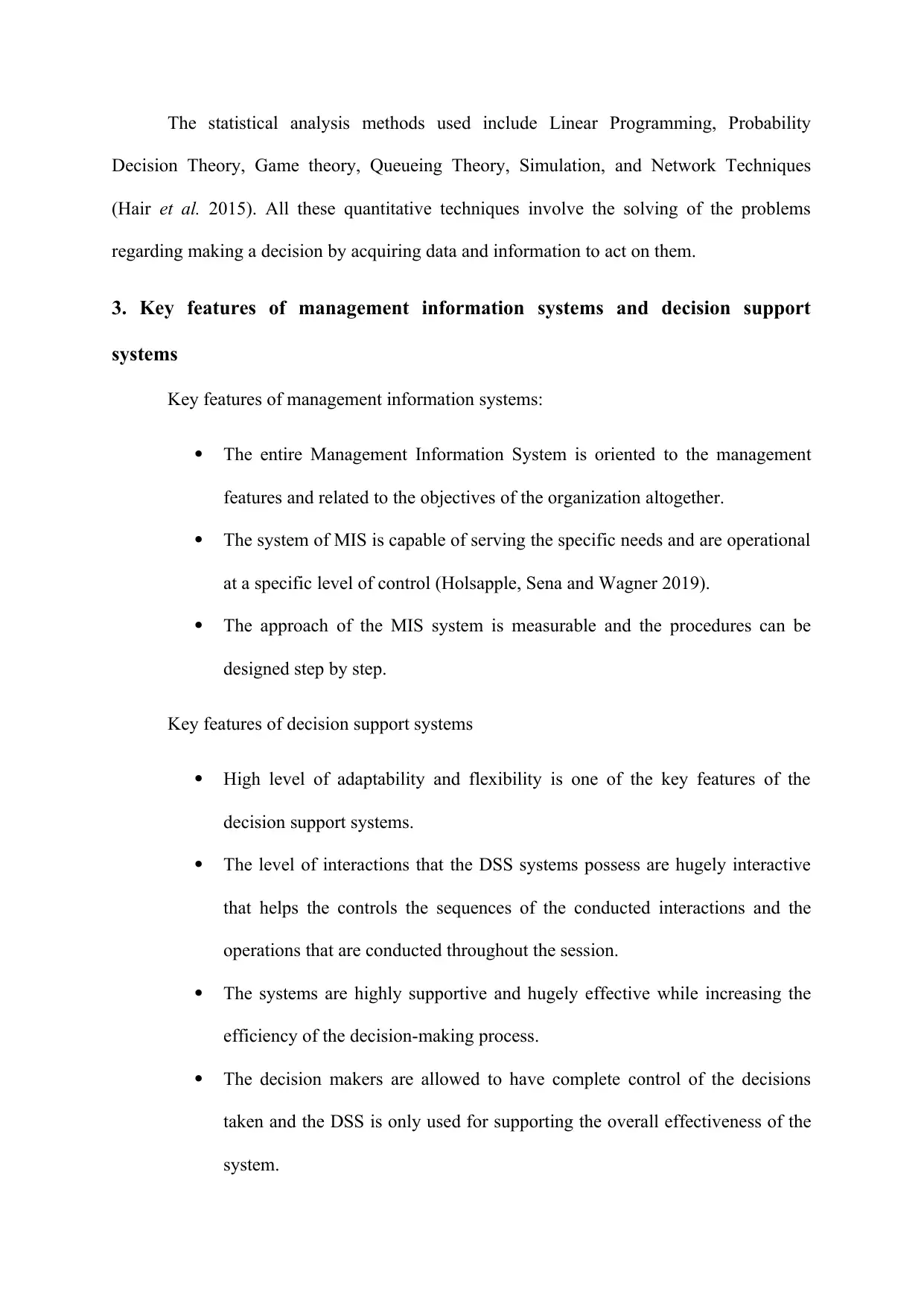
The statistical analysis methods used include Linear Programming, Probability
Decision Theory, Game theory, Queueing Theory, Simulation, and Network Techniques
(Hair et al. 2015). All these quantitative techniques involve the solving of the problems
regarding making a decision by acquiring data and information to act on them.
3. Key features of management information systems and decision support
systems
Key features of management information systems:
The entire Management Information System is oriented to the management
features and related to the objectives of the organization altogether.
The system of MIS is capable of serving the specific needs and are operational
at a specific level of control (Holsapple, Sena and Wagner 2019).
The approach of the MIS system is measurable and the procedures can be
designed step by step.
Key features of decision support systems
High level of adaptability and flexibility is one of the key features of the
decision support systems.
The level of interactions that the DSS systems possess are hugely interactive
that helps the controls the sequences of the conducted interactions and the
operations that are conducted throughout the session.
The systems are highly supportive and hugely effective while increasing the
efficiency of the decision-making process.
The decision makers are allowed to have complete control of the decisions
taken and the DSS is only used for supporting the overall effectiveness of the
system.
Decision Theory, Game theory, Queueing Theory, Simulation, and Network Techniques
(Hair et al. 2015). All these quantitative techniques involve the solving of the problems
regarding making a decision by acquiring data and information to act on them.
3. Key features of management information systems and decision support
systems
Key features of management information systems:
The entire Management Information System is oriented to the management
features and related to the objectives of the organization altogether.
The system of MIS is capable of serving the specific needs and are operational
at a specific level of control (Holsapple, Sena and Wagner 2019).
The approach of the MIS system is measurable and the procedures can be
designed step by step.
Key features of decision support systems
High level of adaptability and flexibility is one of the key features of the
decision support systems.
The level of interactions that the DSS systems possess are hugely interactive
that helps the controls the sequences of the conducted interactions and the
operations that are conducted throughout the session.
The systems are highly supportive and hugely effective while increasing the
efficiency of the decision-making process.
The decision makers are allowed to have complete control of the decisions
taken and the DSS is only used for supporting the overall effectiveness of the
system.
Paraphrase This Document
Need a fresh take? Get an instant paraphrase of this document with our AI Paraphraser
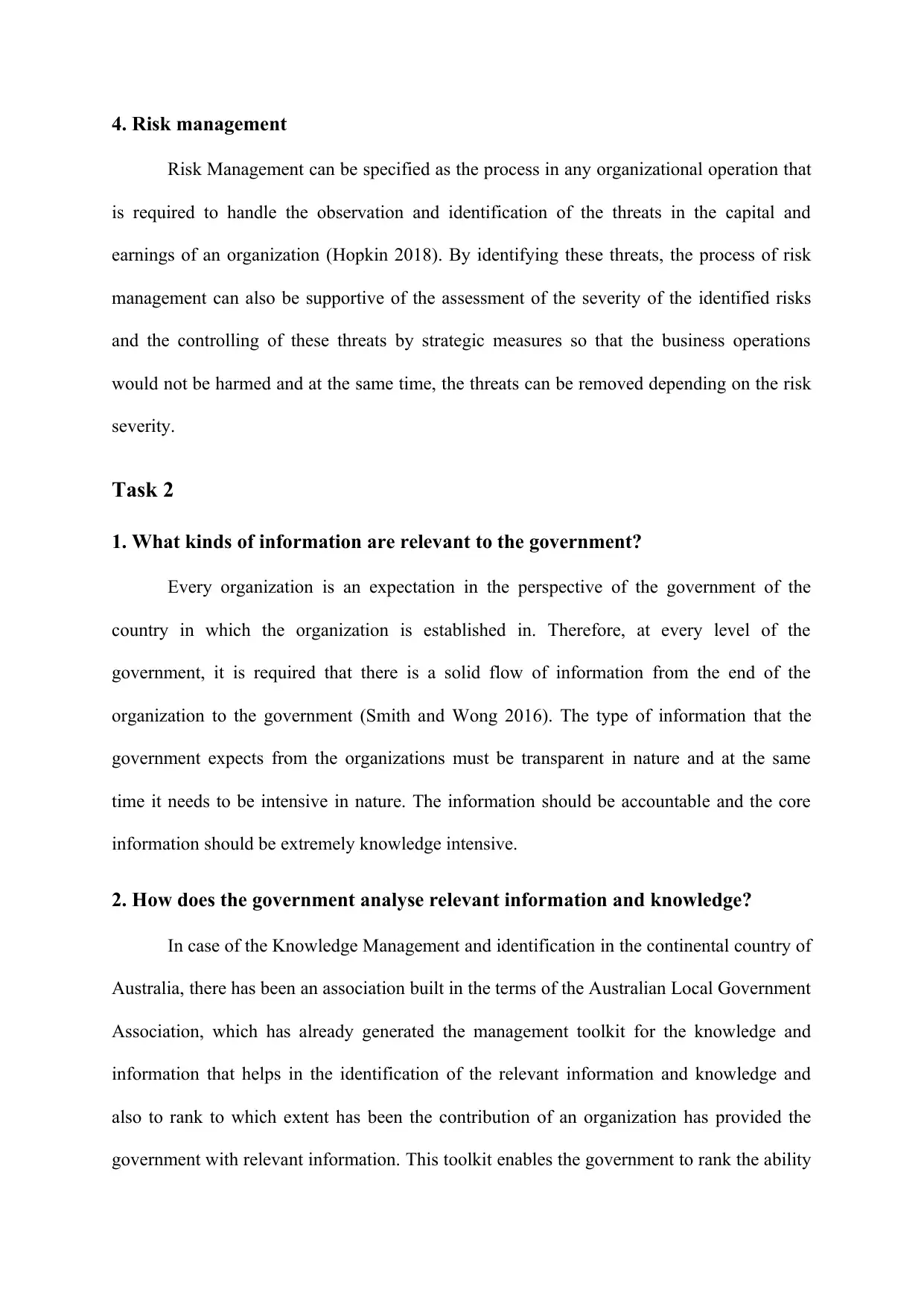
4. Risk management
Risk Management can be specified as the process in any organizational operation that
is required to handle the observation and identification of the threats in the capital and
earnings of an organization (Hopkin 2018). By identifying these threats, the process of risk
management can also be supportive of the assessment of the severity of the identified risks
and the controlling of these threats by strategic measures so that the business operations
would not be harmed and at the same time, the threats can be removed depending on the risk
severity.
Task 2
1. What kinds of information are relevant to the government?
Every organization is an expectation in the perspective of the government of the
country in which the organization is established in. Therefore, at every level of the
government, it is required that there is a solid flow of information from the end of the
organization to the government (Smith and Wong 2016). The type of information that the
government expects from the organizations must be transparent in nature and at the same
time it needs to be intensive in nature. The information should be accountable and the core
information should be extremely knowledge intensive.
2. How does the government analyse relevant information and knowledge?
In case of the Knowledge Management and identification in the continental country of
Australia, there has been an association built in the terms of the Australian Local Government
Association, which has already generated the management toolkit for the knowledge and
information that helps in the identification of the relevant information and knowledge and
also to rank to which extent has been the contribution of an organization has provided the
government with relevant information. This toolkit enables the government to rank the ability
Risk Management can be specified as the process in any organizational operation that
is required to handle the observation and identification of the threats in the capital and
earnings of an organization (Hopkin 2018). By identifying these threats, the process of risk
management can also be supportive of the assessment of the severity of the identified risks
and the controlling of these threats by strategic measures so that the business operations
would not be harmed and at the same time, the threats can be removed depending on the risk
severity.
Task 2
1. What kinds of information are relevant to the government?
Every organization is an expectation in the perspective of the government of the
country in which the organization is established in. Therefore, at every level of the
government, it is required that there is a solid flow of information from the end of the
organization to the government (Smith and Wong 2016). The type of information that the
government expects from the organizations must be transparent in nature and at the same
time it needs to be intensive in nature. The information should be accountable and the core
information should be extremely knowledge intensive.
2. How does the government analyse relevant information and knowledge?
In case of the Knowledge Management and identification in the continental country of
Australia, there has been an association built in the terms of the Australian Local Government
Association, which has already generated the management toolkit for the knowledge and
information that helps in the identification of the relevant information and knowledge and
also to rank to which extent has been the contribution of an organization has provided the
government with relevant information. This toolkit enables the government to rank the ability
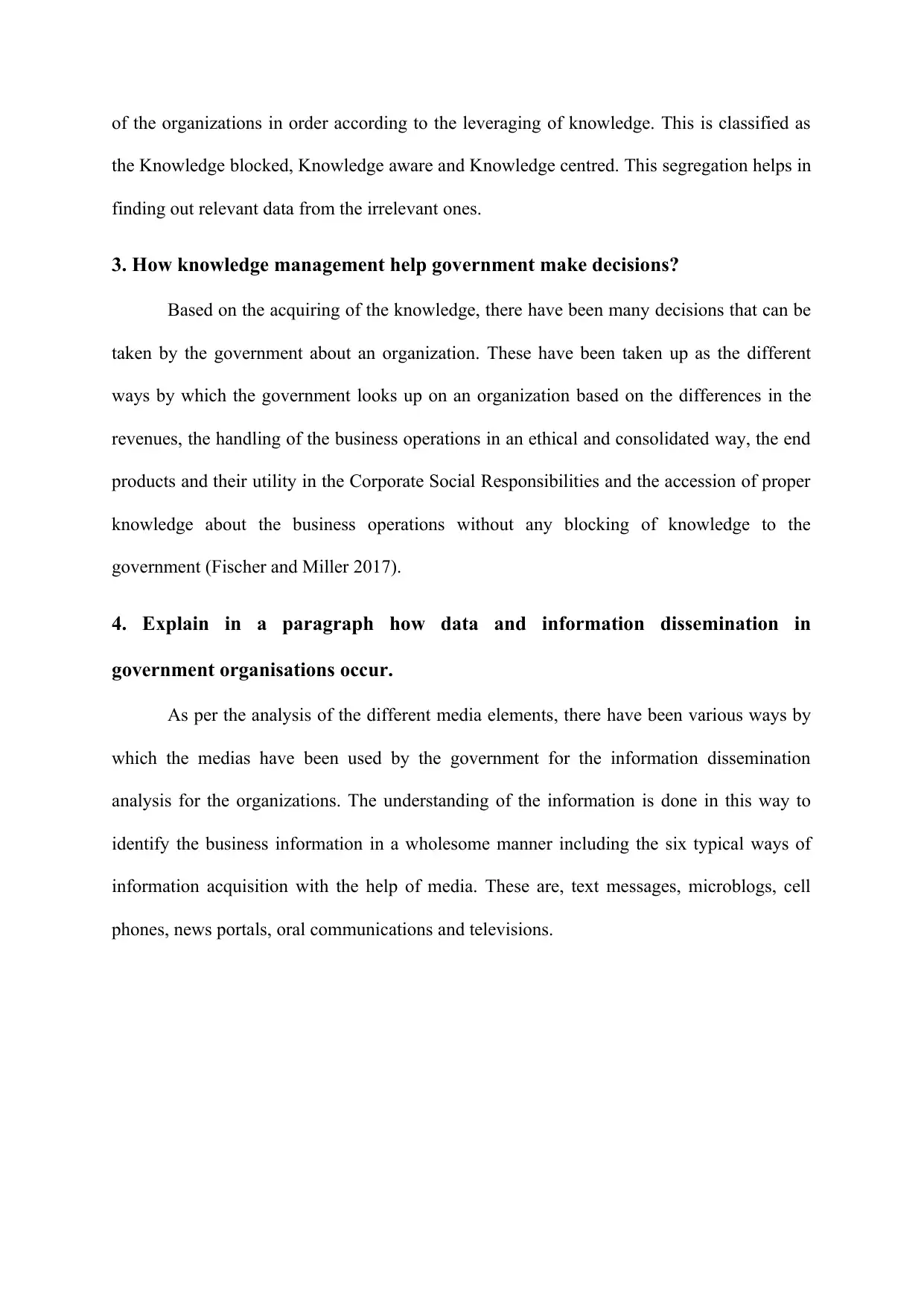
of the organizations in order according to the leveraging of knowledge. This is classified as
the Knowledge blocked, Knowledge aware and Knowledge centred. This segregation helps in
finding out relevant data from the irrelevant ones.
3. How knowledge management help government make decisions?
Based on the acquiring of the knowledge, there have been many decisions that can be
taken by the government about an organization. These have been taken up as the different
ways by which the government looks up on an organization based on the differences in the
revenues, the handling of the business operations in an ethical and consolidated way, the end
products and their utility in the Corporate Social Responsibilities and the accession of proper
knowledge about the business operations without any blocking of knowledge to the
government (Fischer and Miller 2017).
4. Explain in a paragraph how data and information dissemination in
government organisations occur.
As per the analysis of the different media elements, there have been various ways by
which the medias have been used by the government for the information dissemination
analysis for the organizations. The understanding of the information is done in this way to
identify the business information in a wholesome manner including the six typical ways of
information acquisition with the help of media. These are, text messages, microblogs, cell
phones, news portals, oral communications and televisions.
the Knowledge blocked, Knowledge aware and Knowledge centred. This segregation helps in
finding out relevant data from the irrelevant ones.
3. How knowledge management help government make decisions?
Based on the acquiring of the knowledge, there have been many decisions that can be
taken by the government about an organization. These have been taken up as the different
ways by which the government looks up on an organization based on the differences in the
revenues, the handling of the business operations in an ethical and consolidated way, the end
products and their utility in the Corporate Social Responsibilities and the accession of proper
knowledge about the business operations without any blocking of knowledge to the
government (Fischer and Miller 2017).
4. Explain in a paragraph how data and information dissemination in
government organisations occur.
As per the analysis of the different media elements, there have been various ways by
which the medias have been used by the government for the information dissemination
analysis for the organizations. The understanding of the information is done in this way to
identify the business information in a wholesome manner including the six typical ways of
information acquisition with the help of media. These are, text messages, microblogs, cell
phones, news portals, oral communications and televisions.
⊘ This is a preview!⊘
Do you want full access?
Subscribe today to unlock all pages.

Trusted by 1+ million students worldwide
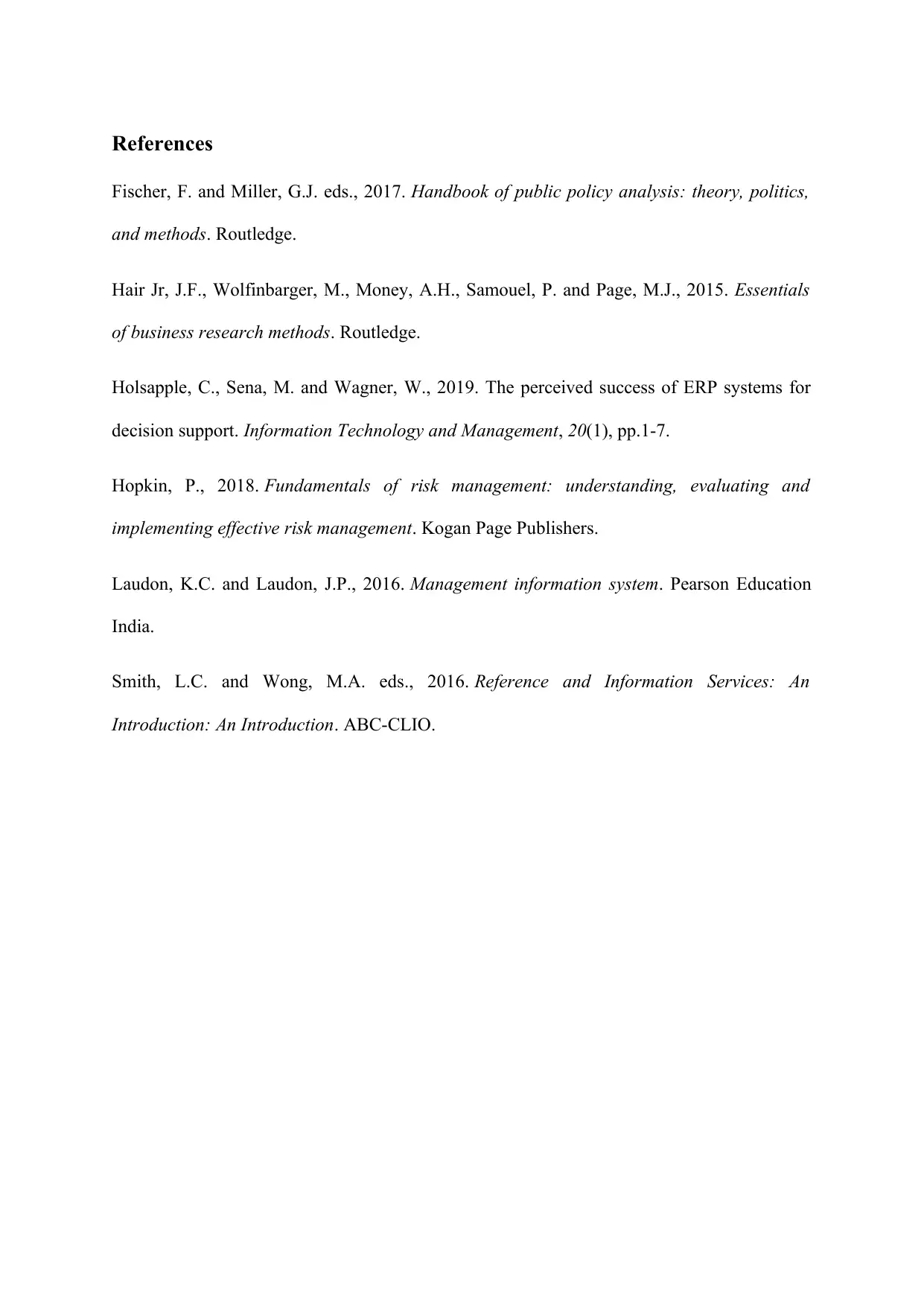
References
Fischer, F. and Miller, G.J. eds., 2017. Handbook of public policy analysis: theory, politics,
and methods. Routledge.
Hair Jr, J.F., Wolfinbarger, M., Money, A.H., Samouel, P. and Page, M.J., 2015. Essentials
of business research methods. Routledge.
Holsapple, C., Sena, M. and Wagner, W., 2019. The perceived success of ERP systems for
decision support. Information Technology and Management, 20(1), pp.1-7.
Hopkin, P., 2018. Fundamentals of risk management: understanding, evaluating and
implementing effective risk management. Kogan Page Publishers.
Laudon, K.C. and Laudon, J.P., 2016. Management information system. Pearson Education
India.
Smith, L.C. and Wong, M.A. eds., 2016. Reference and Information Services: An
Introduction: An Introduction. ABC-CLIO.
Fischer, F. and Miller, G.J. eds., 2017. Handbook of public policy analysis: theory, politics,
and methods. Routledge.
Hair Jr, J.F., Wolfinbarger, M., Money, A.H., Samouel, P. and Page, M.J., 2015. Essentials
of business research methods. Routledge.
Holsapple, C., Sena, M. and Wagner, W., 2019. The perceived success of ERP systems for
decision support. Information Technology and Management, 20(1), pp.1-7.
Hopkin, P., 2018. Fundamentals of risk management: understanding, evaluating and
implementing effective risk management. Kogan Page Publishers.
Laudon, K.C. and Laudon, J.P., 2016. Management information system. Pearson Education
India.
Smith, L.C. and Wong, M.A. eds., 2016. Reference and Information Services: An
Introduction: An Introduction. ABC-CLIO.
1 out of 7
Related Documents
Your All-in-One AI-Powered Toolkit for Academic Success.
+13062052269
info@desklib.com
Available 24*7 on WhatsApp / Email
![[object Object]](/_next/static/media/star-bottom.7253800d.svg)
Unlock your academic potential
Copyright © 2020–2025 A2Z Services. All Rights Reserved. Developed and managed by ZUCOL.





